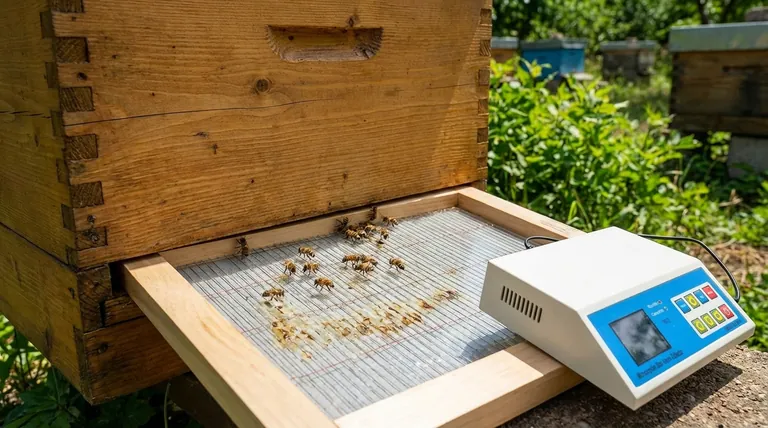In modern apiculture, the standard duration for "milking" a single bee colony for its venom is a brief 5 minutes. This process involves a specialized collection device placed at the hive entrance which stimulates the bees to deposit venom without causing them fatal harm.
The 5-minute collection window is a carefully calibrated balance. It is designed to maximize the yield of venom from guard bees while critically minimizing the overall stress and disruption to the colony's health and stability.

How Bee Venom Collection Works
The process of "milking" bees is not mechanical but rather a stimulation of their natural defensive behaviors. It relies on a specific piece of technology that is both simple and ingenious.
The Collector Device
The core of the system is a glass plate collector. This device is a frame containing a grid of wires stretched over a pane of glass.
This collector is typically placed at the entrance of the beehive, where it will be encountered by foraging and guard bees.
The Role of a Mild Electrical Current
The wires in the grid carry a very low-voltage electrical current. When a bee lands on the grid, it completes a circuit and receives a mild shock.
This shock is not strong enough to kill or seriously injure the bee. Its purpose is purely to agitate the bee and trigger its defensive stinging response.
The Bee's Natural Response
In response to the stimulation, the bee instinctively stings the surface it is on—in this case, the glass plate beneath the wires.
Because the bee stings a hard, smooth surface like glass, its barbed stinger cannot get lodged. The bee deposits a small amount of venom and flies away unharmed, unlike when it stings skin. The venom quickly dries on the plate for later collection.
Why the 5-Minute Duration is Critical
The 5-minute timeframe is not arbitrary. It is the result of balancing the need for an effective harvest with the ethical imperative to preserve the well-being of the hive.
Maximizing Venom Yield
A 5-minute period is sufficient to agitate a significant number of bees as they enter or exit the hive. This ensures a viable quantity of venom is collected during the session.
Minimizing Harm to the Bees
While individual bees survive the process, the electrical stimulation is stressful. Limiting the exposure to just 5 minutes prevents prolonged agitation and exhaustion within the colony.
Preventing Widespread Colony Alarm
A longer duration risks triggering a full-scale alarm response. Bees release alarm pheromones when they feel threatened, which could cause mass agitation, defensive swarming, and significant, long-lasting stress to the entire colony. The short duration contains the event to a minor disturbance.
Understanding the Trade-offs
While modern venom collection is designed to be non-lethal, it is essential to acknowledge the inherent impact on the hive.
Inevitable Stress on the Colony
The process is, by design, an irritant. Responsible beekeepers must monitor their colonies closely and ensure they are strong and healthy before attempting any venom collection.
Collection Frequency is Limited
A colony requires time to recover from the stress of a collection event. Beekeepers cannot perform this procedure daily; a significant rest period between sessions is necessary to maintain the long-term health of the hive.
Key Principles for Responsible Collection
Applying this technique requires a focus on the health of the apiary, not just the yield of the product.
- If your primary focus is bee welfare: Limit collection sessions to the 5-minute standard and provide ample recovery time between collections for any given hive.
- If your primary focus is venom quality: Ensure the glass plate is perfectly clean before use and that the dried venom is scraped and stored in a controlled environment to prevent contamination.
- If your primary focus is sustainable yield: Rotate collection among multiple strong, healthy hives rather than repeatedly stressing a single colony.
Ultimately, effective bee venom collection hinges on respecting the biological limits and well-being of the colony.
Summary Table:
| Aspect | Detail |
|---|---|
| Standard Duration | 5 minutes per session |
| Primary Goal | Maximize venom yield while minimizing colony stress |
| Collection Method | Mild electrical stimulation via a glass plate collector |
| Bee Outcome | Non-lethal; bees fly away unharmed |
| Key Consideration | Requires significant recovery time between sessions |
Optimize Your Venom Collection with Professional-Grade Equipment
Are you a commercial apiary or beekeeping equipment distributor looking to implement sustainable and efficient venom collection practices? HONESTBEE supplies the durable, wholesale-focused beekeeping supplies and equipment you need. Our robust collection devices are designed for the demands of high-volume operations, helping you maximize yield without compromising colony health.
Contact our experts today to discuss how our wholesale solutions can support your apiary's productivity and long-term sustainability.
Visual Guide

Related Products
- Full Set Beekeeping Electronic Bee Venom Collector Machine Device for Bee Venom Collecting
- 8-Frame Electric Self-Reversing Honey Extractor Spinner for Commercial Honey Extraction Equipment
- No Grafting Queen Rearing Kit: System for Royal Jelly Production and Queen Rearing
- HONESTBEE Bee Frame Grooving Machine | Precision Slotting for Bee Frame Making
- Nicot Queen Rearing Kit for Beekeeping and Grafting in Nicot System
People Also Ask
- How is bee venom typically collected using the electro-shock method? A Guide to Efficient, Non-Lethal Harvesting
- How frequently should pollen be harvested from the traps? Ensure Optimal Hive Health & Superior Quality
- How is the venom collection apparatus utilized across multiple hives? A Guide to Efficient Rotation & Bee Health
- How much venom can be collected from a single bee? A Microscopic Yield of Immense Value
- How frequently should pollen be collected for human consumption? Optimize Your Harvesting Schedule



















